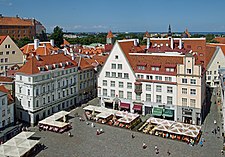
Back Tourismus in Estland German Eesti turism ET Turismo in Estonia Italian Turismo na Estônia Portuguese Estonya'da turizm Turkish Estoniya turizm sanoati UZ

Tourism in Estonia refers to the overall state of the tourism industry in the Baltic nation of Estonia. It is a key part of the country's economy, contributing 7.8% to its GDP, and employing 4.3% of its population.[1] In 2018, tourism and other related services counted for over 10.8 percent of Estonia's exports. Tourism is increasing rapidly in Estonia: the number of tourist arrivals—both domestic and international—has increased from 2.26 million in 2006 to 3.79 million in 2019.[2] Estonia was also ranked the 15th-most safest country to visit in 2017, according to safedestinations.com, scoring 8.94 out of 10 on their list.[3] In a 2018 report published by the OECD, they concluded that most international tourists come from places like Finland, Russia, Latvia, Germany, and Sweden.[1]
National tourism in Estonia is managed by the Ministry of Economic Affairs and Communications (Estonian: Majandus- ja Kommunikatsiooniministeerium), which works closely with the national tourist agency, the Estonian Tourist Board. In 2014, the Government of Estonia announced the National Tourist Development Plan, a project meant to invest 123 million euros into the Estonian travel industry,[4] meant to last until 2020. After 2020, when the plan ended, the Ministry announced a new plan starting from 2021 and ending in 2024, entitled the "Tourism Programme 2021–24", with help from the Ministry of Education and Research.[5]
In the context of tourism in general, Estonia, along with other Baltic states, is considered a newly-freed Eastern Bloc nation with a rich history and untouched nature.[6] Popular destinations in Estonia include the national capital of Tallinn, Tartu, Pärnu, and Saaremaa, of which the Old Town in Tallinn is a designated UNESCO World Heritage Site. Additionally, Estonia is also a popular destination for foreign students: 5,528 students from external countries studied in Estonia, mostly from neighboring countries, but also occasionally from places like Azerbaijan, Nigeria, and India,[7] comprising 12.2% of all students in Estonia.[8]
- ^ a b "Estonia: Tourism in the economy". oced.org. 2020. Archived from the original on 22 September 2021. Retrieved 22 September 2021.
- ^ "Number of arrivals in tourist accommodation in Estonia from 2006 to 2019 (in millions)". Statista. 2021. Archived from the original on 22 September 2021.
- ^ "Rankings of Safest Countries For Travel". safedestinations.com. 10 September 2021. Archived from the original on 22 September 2021.
- ^ Ministry of Economic Affairs and Communications, Republic of Estonia (18 June 2019). "Tourism | Ministry of Economic Affairs and Communications". Ministry of Economic Affairs and Communications. Archived from the original on 22 September 2021.
- ^ Ministry of Education and Research, Republic of Estonia (21 October 2019). "Strategic planning from 2021–2035". Ministry of Education and Research (Estonia).
- ^ Cottrell, Stuart; Cottrell, Jana Raadik (2015). "The State of Tourism in the Baltics". Scandinavian Journal of Hospitality & Tourism. 15 (4). Taylor & Francis: 321–326. doi:10.1080/15022250.2015.1081798. S2CID 155121200.
- ^ "Statistics: International Students at Estonian Universities in 2020". studyinestonia.ee. 9 December 2020. Archived from the original on 22 September 2021.
- ^ "Statistics: Over 5,500 foreign students study in Estonia". Eesti Rahvusringhääling. 27 May 2020. Archived from the original on 20 October 2021.